Page last updated June 3, 2021
Completed PGC 44908
PGC 44709
A magnitude 15.8 lenticular galaxy (type S(rs)0/a?) in Coma Berenices (RA 13 00 10.2, Dec +27 51 50)
Physical Information: Based on a recessional velocity of 9900 km/sec (and H0 = 70 km/sec/Mpc), a straightforward calculation indicates that PGC 44709 is about 460 million light-years away. However, for objects at such distances we should take into account the expansion of the Universe during the time it took their light to reach us. Doing that shows that the galaxy was about 445 million light-years away at the time the light by which we see it was emitted, about 450 million years ago (the difference between the two numbers being due to the expansion of the intervening space during the light-travel time). Given that and its apparent size of about 0.35 by 0.35 arcmin (from the images below), the galaxy is about 45 thousand light-years across. Note: Although generally listed as a member of the Coma Cluster, its large recessional velocity probably means that PGC 44709 is actually a background galaxy; and although it appears to be a companion of PGC 44716, it is at least 150 million light-years further away from us.

Above, a 12 arcmin wide SDSS image centered on PGC 44709, also showing NGC 4876 and 4898
Below, a 1.8 arcmin wide SDSS image of the galaxy and three of its nearest neighbors
(PGC 44716, PGC 126762 and "PGC 4628454")

Below, a 1.75 by 1.25 arcmin wide HST image of the region (Image Credit ESA/Hubble & NASA, Cramer et al.)
Also shown, in false-color, is the gas torn from PGC 44716 by ram-pressure stripping
(Note: The HST press release understates the apparent size of the region)
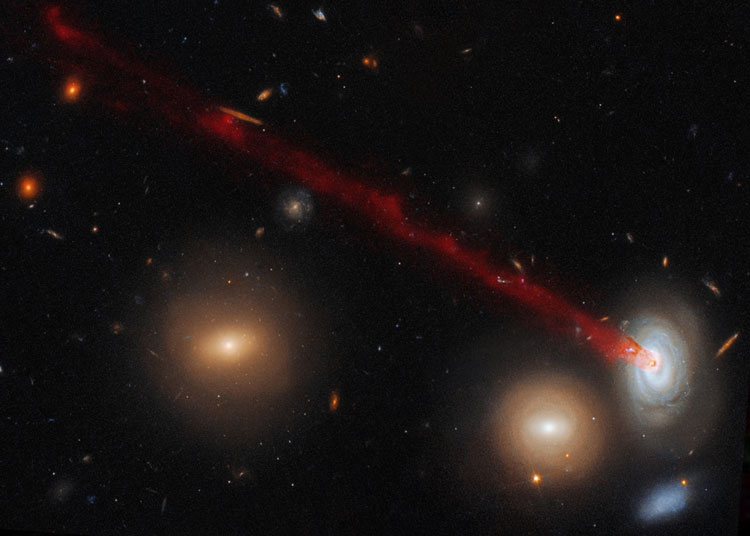
Below, a 0.7 by 0.75 arcmin wide HST image of the region near PGC 44709 (Image Credit as above)
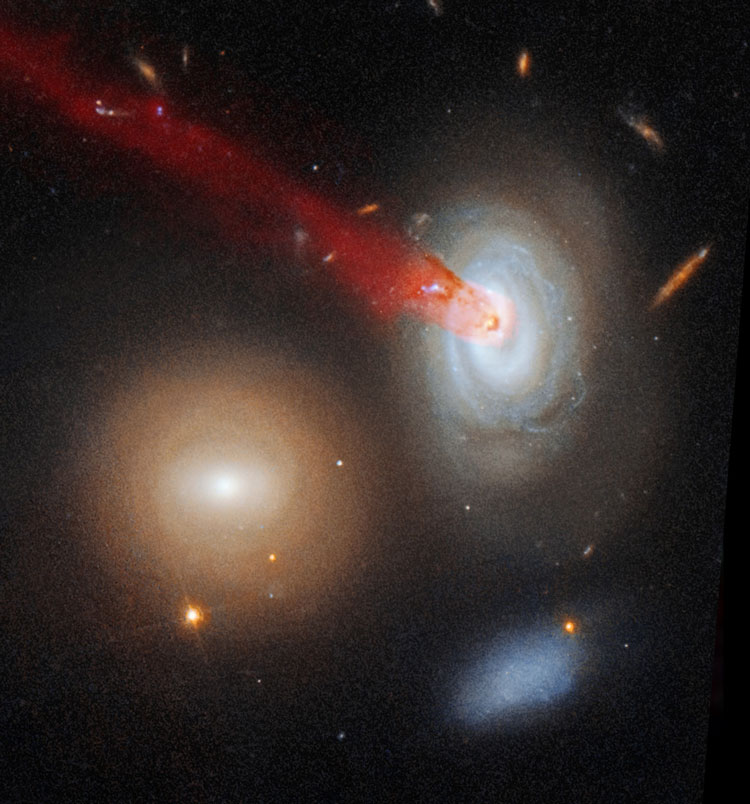
PGC 44716
A magnitude 15.6 spiral galaxy (type SABa?) in Coma Berenices (RA 13 00 09.2, Dec +27 51 59)
Designation Note: NED incorrectly lists PGC 44716 as the apparent pair of galaxies, PGC 44716 and PGC 44709 (apparent, because they are actually at very different distances). As a result, a search of NED for PGC 44716 should use MRK 0060 NED01 or SDSS J130009.14+275159.3.
Physical Information: Based on a recessional velocity of 5135 km/sec (and H0 = 70 km/sec/Mpc), PGC 44716 is about 240 million light-years away, but it is thought to be a member of the Coma Cluster of galaxies, which is about 320 million light-years away, and the ram-pressure stripping of gas in its core by its motion through the intergalactic medium which fills that cluster (and may have even more mass than the galaxies in the cluster) pretty much confirms that it is a member of the Cluster (although probably in the part of the cluster closer to us), and merely has a peculiar (non-Hubble expansion) velocity well in excess of 1000 km/sec (which would help explain the spectacular effect of its motion through the intergalactic medium). Such large 'peculiar' motions are not unusual in very rich clusters of galaxies, because the large mass of the cluster can allow it to hold onto galaxies with large peculiar motions, and in fact is usually the cause of those motions. Assuming that it is on the 'near' side of the Coma Cluster and using an estimated distance of about 300 million light-years and its apparent size of about 0.4 by 0.25 arcmin (from the images below), PGC 44716 is about 35 thousand light-years across.
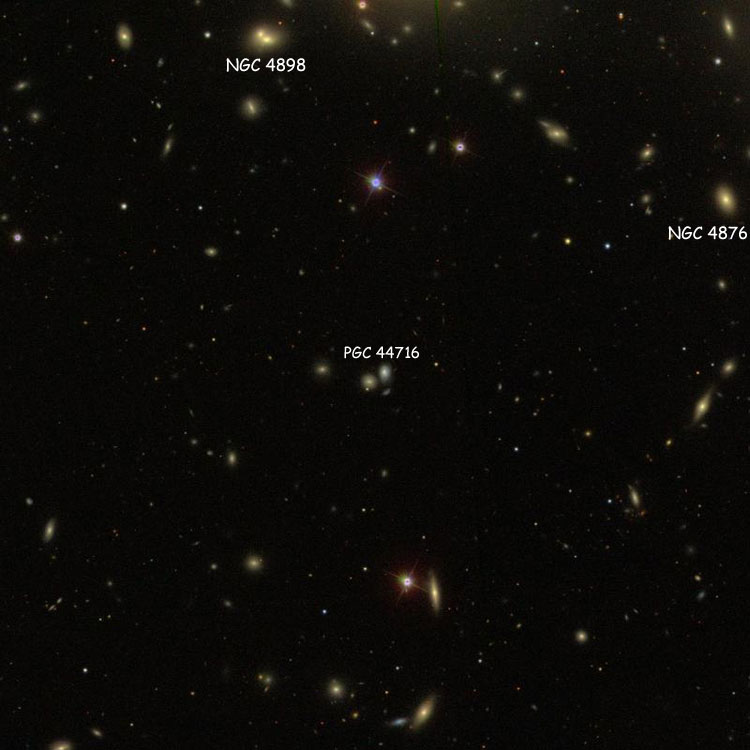
Above, a 12 arcmin wide SDSS image centered on PGC 44716, also showing NGC 4876 and 4898
Below, a 1.8 arcmin wide SDSS image of the galaxy and three of its nearest neighbors
(PGC 44709, PGC 126762 and "PGC 4628454"

Below, a 1.75 by 1.25 arcmin wide HST image of the region (Image Credit ESA/Hubble & NASA, Cramer et al.)
Also shown, in false-color, is the gas torn from PGC 44716 by ram-pressure stripping
(Note: The HST press release understates the apparent size of the region)

Below, a 0.7 by 0.75 arcmin wide HST image of the region near PGC 44716 (Image Credit as above)

PGC 44908 (not = IC 843)
(= UGC 8137 = CGCG 160-099 = MCG +05-31-100)
(and perhaps/probably = NGC 4912)
Perhaps/probably discovered (Apr 24, 1865) by Lawrence Parsons, 4th Lord Rosse
Almost certainly not observed (May 3, 1866) by Truman Safford
A magnitude 13.6 lenticular galaxy (type S0?) in Coma Berenices (RA 13 01 33.6, +29 07 50)
Historical (Mis)Identifications: Dreyer attributed this object, listed as IC 843, to Truman Safford; but there is no question that Safford did not observe it, but what became IC 4088, instead, hence the note about Safford above. Whether Lawrence Parsons observed it is also uncertain, but thanks to Sue French's work, a very likely possibility, hence the note about him above. For a discussion of Safford's observation, see IC 843. For a discussion of Parsons' observation, see NGC 4912.
Physical Information:
PGC 44918
(= ESO 443-034 = MCG-05-31-018)
Not observed (Mar 30, 1835) by John Herschel
A magnitude 13(?) lenticular galaxy (type (R')SB(rs)0/a? pec) in Centaurus (RA 13 01 41.7, Dec -30 54 44)
Why Isn't This An NGC Object?: Although Herschel observed both of the galaxies (NGC 4903 and 4905) to the west of this one on the date shown above, his records do not mention this "nebula", despite its being the brightest of the three. However, he also failed to mention the bright star and double star to the east of NGC 4905, so the only reasonable conclusion is that the unmentioned objects must have been just to the east of his field of view as (per Corwin) he "slewed" through the area.
Physical Information: Based on a recessional velocity relative to the Cosmic Microwave Background radiation of 5635 km/sec (and H0 = 70 km/sec/Mpc), PGC 44918 is about 260 to 265 million light-years away, in good agreement with a single redshift-independent distance estimate of about 270 to 275 million light-years. Given that and its apparent size of about 2.8 by 2.55 arcmin (from the images below, including faint outer regions), the galaxy is about 210 to 220 thousand light-years across.
Classification Note: A single spiral arm and several faint outer regions form partial rings around an otherwise SB0 galaxy, resulting in the "type" shown above.

Above, a 12 arcmin wide DSS image centered on PGC 44918, also showing NGC 4903 and 4905
Below, the same region in a PanSTARRS/DSS composite image
(At this declination, PanSTARRS images have many missing regions)
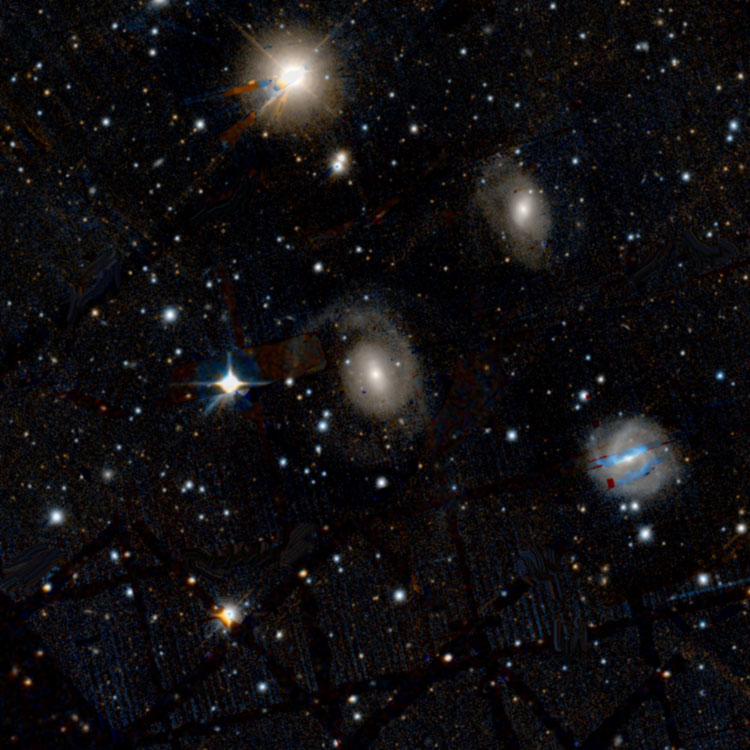
Below, a 3.75 arcmin wide DSS image of the galaxy

Below, a 1.2 arcmin wide PanSTARRS image of the central part of the galaxy
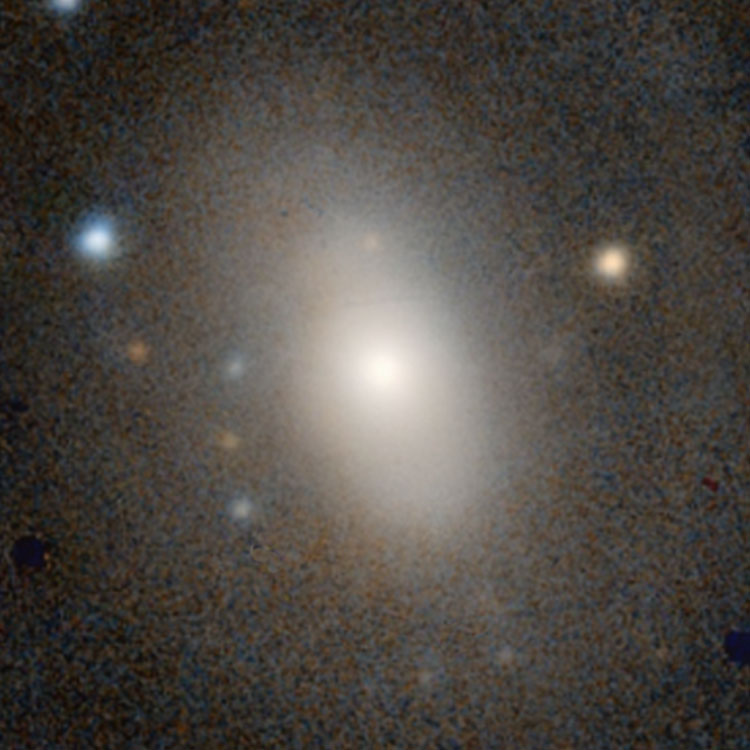
|